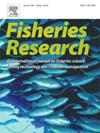Site-specific post-release predation of bonefish (Albula glossodonta) in a catch-and-release recreational fishery: informing voluntary actions and management strategies for a Blue Economy
IF 2.2
2区 农林科学
Q2 FISHERIES
引用次数: 0
Abstract
Bonefish (Albula spp.) support recreational catch-and-release (C&R) fisheries in tropical and subtropical regions, contributing to conservation efforts and advancing Blue Economy initiatives. However, post-release predation (PRP) poses challenges to the sustainability of these fisheries, particularly in predator-dense environments. This study assessed physical injury, reflex impairment, and PRP for bonefish (Albula glossodonta) in the Alphonse Group of islands, Republic of Seychelles, a well-established sport fishing destination. There was a significant effect of air exposure on reflex impairment, with fish exposed to air for 30 seconds being more impaired than those exposed to 0 or 10 seconds. However, air exposure, among other angling event characteristics, did not affect PRP (overall PRP = 13 %). Notably, PRP was highly site-specific, with 75 % of predation events occurring at a single location where bonefish were 15 times more likely to be predated compared to other sites. Cryptic predation was prevalent, as only 17 % of predation events were preceded by observing potential predators. Sicklefin lemon sharks (Negaprion acutidens) were responsible for most PRP, often tracking and preying on bonefish within an average of 9 minutes after release (30–1080 seconds; 545 ± 315 seconds). To reduce PRP risk, these findings highlight the need for regular PRP assessments, adaptive management, and site-specific strategies that include voluntary actions of anglers and guides to avoid locations where PRP is prevalent. Incorporating evidence-informed practices into conservation and management plans can promote sustainable recreational fisheries while supporting conservation and economic growth in a Blue Economy.
休闲渔业捕捞和释放中特定地点的骨鱼(Albula glossodonta)释放后捕食:为蓝色经济的自愿行动和管理策略提供信息
骨鱼支持热带和亚热带地区的休闲捕捞和释放渔业,为保护工作和推进蓝色经济倡议做出贡献。然而,释放后捕食(PRP)对这些渔业的可持续性提出了挑战,特别是在捕食者密集的环境中。本研究评估了塞舌尔共和国阿方斯群岛(Alphonse Group of islands)的骨鱼(Albula glossodonta)的身体损伤、反射障碍和PRP。塞舌尔共和国是一个完善的钓鱼运动目的地。暴露在空气中对反射损伤有显著影响,暴露在空气中30 秒的鱼比暴露在空气中0或10 秒的鱼受到的损伤更大。然而,空气暴露,以及其他钓鱼事件特征,不影响PRP(总体PRP = 13 %)。值得注意的是,PRP具有高度的地点特异性,75% %的捕食事件发生在一个地点,与其他地点相比,该地点的骨鱼被捕食的可能性高15倍。隐捕食是普遍存在的,因为只有17% %的捕食事件发生前观察潜在的捕食者。镰状叶柠檬鲨(Negaprion acutidens)负责大多数PRP,通常在释放后平均9 分钟(30-1080 秒)内跟踪并捕食骨鱼; 545±315 秒)。为了降低PRP风险,这些研究结果强调需要定期进行PRP评估、适应性管理和特定地点的策略,包括垂钓者和向导的自愿行动,以避免PRP流行的地点。将循证实践纳入养护和管理计划可以促进可持续休闲渔业,同时支持蓝色经济中的养护和经济增长。
本文章由计算机程序翻译,如有差异,请以英文原文为准。
求助全文
约1分钟内获得全文
求助全文
来源期刊

Fisheries Research
农林科学-渔业
CiteScore
4.50
自引率
16.70%
发文量
294
审稿时长
15 weeks
期刊介绍:
This journal provides an international forum for the publication of papers in the areas of fisheries science, fishing technology, fisheries management and relevant socio-economics. The scope covers fisheries in salt, brackish and freshwater systems, and all aspects of associated ecology, environmental aspects of fisheries, and economics. Both theoretical and practical papers are acceptable, including laboratory and field experimental studies relevant to fisheries. Papers on the conservation of exploitable living resources are welcome. Review and Viewpoint articles are also published. As the specified areas inevitably impinge on and interrelate with each other, the approach of the journal is multidisciplinary, and authors are encouraged to emphasise the relevance of their own work to that of other disciplines. The journal is intended for fisheries scientists, biological oceanographers, gear technologists, economists, managers, administrators, policy makers and legislators.
 求助内容:
求助内容: 应助结果提醒方式:
应助结果提醒方式:


